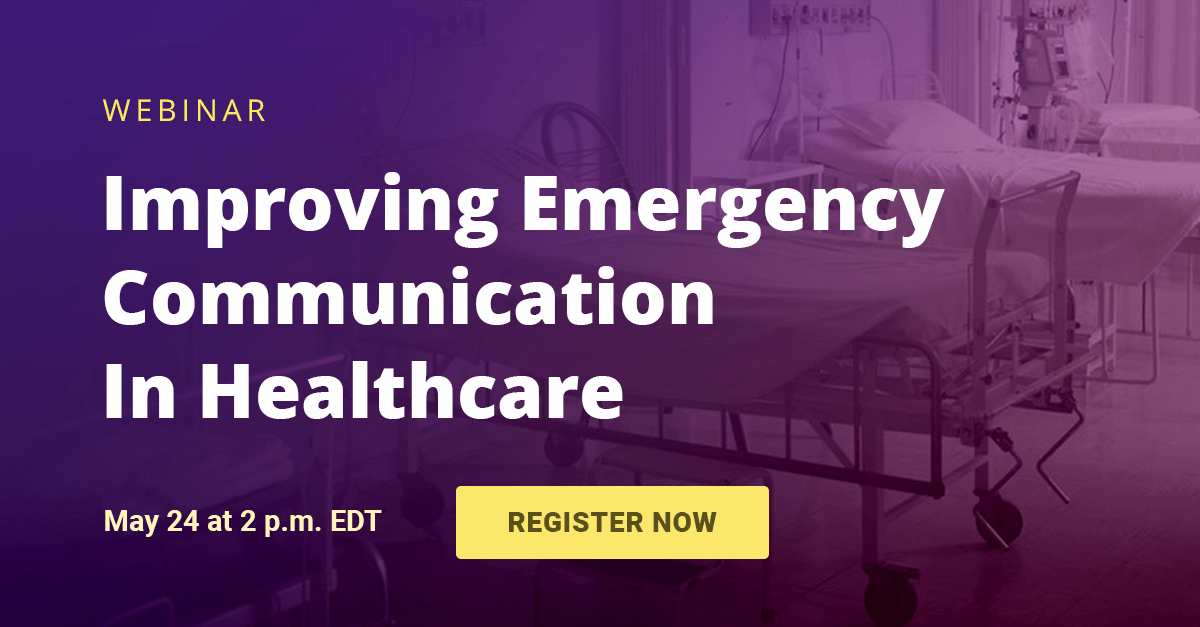Who Takes Care Of Your Team When Emergencies Occur In Your Hospital?
Emergency preparedness planning for healthcare organizations is complex, requiring planners to account for both patients and employees. Complying with the new CMS Emergency Preparedness Rule doesn’t have to be an arduous task.
With some expert advice from Meg Nash, MPH, in our new webinar, “Improving Emergency Communications Under The Emergency Preparedness Rule: Are You Ready?,” providers can learn how to protect their organization and comply with the new regulations.
Understanding The CMS Emergency Preparedness Rule
The Centers for Medicare & Medicaid Services (CMS) emergency preparedness rule was enacted in November 2017 and established national requirements to guarantee adequate planning for both natural and man-made disasters, and coordination with federal, state, tribal, regional and local emergency preparedness systems. It directly affects healthcare providers that receive Medicare and Medicaid reimbursements.
What Makes Healthcare Emergency Communications Unique
Healthcare providers are different from most other businesses in that they are one of the few places that see surges of activity in the face of emergencies like pandemics and natural disasters.
Conversely, their preparedness plans for an active shooter may call for a lockdown of certain areas while keeping others operational and secured to finish medical procedures and surgeries.
Communication among staff and management is integral in protecting patients and employees while still providing lifesaving care.
Continuing Care During Emergencies
Continuing medical care is on the mind of everyone involved in healthcare emergency preparedness. Surgeries, treatments and other procedures are constantly in progress, and without the proper contingencies in place, these situations can turn deadly.
Whether the crisis forces a lockdown or evacuation, Meg Nash, MPH, a FEMA trainer, said each healthcare organization needs to decide what level of communication and type of message they want to send. “Complex organizations may need to define the message differently based on people's location,” she said, “whereas simple organizations may just need to send out a message that is actionable and informs employees on what to do.”
Creating Clear, Direct Communication
Nash said the guidelines healthcare providers need to follow for their alerts are simple. “Keep it short and direct. It's got to be reinforced and it has to be on multiple channels,” she said.
Texts, emails, public announcements, pages and hotlines should all be used to send these messages to recipients. “Your alerts need to be actionable. Any miscommunication you have during an event can have huge, negative effects,” she said.
Nash also stressed that in many cases, you should be thinking more about the effect of the threat than the threat itself.
“If people look at it from that perspective of ‘I can't communicate with people because,’ they tend to get more flexible and more creative,” she said. “So if they can’t send out a mass alert, then they know they go to this person on the third floor and ask them. And that person, like a physical phone tree, then distributes this information.”
You can find more ideas about how to identify and prepare for the threats facing your organization and build an effective emergency communication plan with pre-scripted alerts in AlertFind's eBook, The Right Communication At The Right Time: Emergency Communications And Alert Strategies.
Using Two-Way Communication
In addition to clear, concise alerts, healthcare providers also need to use two-way communication. This allows the recipients of the alerts to send back relevant information.
“Two-way communications are essential in rapidly-evolving situations or where there’s poor situational awareness creating a high degree of risk to patients, staff or facility,” Nash said. “[It] definitely allows for more on-the-spot decision making so that when we're making our plans we don't necessarily need to envision every eventuality and every possible modification to it. In today's world, some situations benefit from the ability to make a decision in that moment and get that information out immediately.”
For example, if a nurse needs to shelter-in-place with a patient, they can send information to the incident commander about the number of people, if there are any injuries, and any other relevant information like threats or obstacles for first responders.
Contacting Employees By Role
Your communication plan should outline who will be notified in an emergency and how information will be distributed.
For example, you may want to contact all the scrub nurses in an event of a lockdown and give them the information about the incident and what they need to do. “As part of your training, they know they’re in the role that will receive the communication and will be responsible for passing on information to the appropriate people,” Nash said. “This mitigates the risk of someone interrupting the procedure and also lets them know the next steps.”
This segmented communication not only gives them the required actions they need to take, it also allows the incident commander to ask detailed questions, which could include, “Are you in an active surgical procedure? Which suite are you in? Have you opened the patient?”
This gives the incident commander valuable information that he or she can act on quickly. It also avoids the potential for conflicting reports or incorrect information.
Meg Nash, MPH, will help healthcare organizations understand how to best comply with the new requirements in AlertFind’s new webinar, “Improving Emergency Communications Under The Emergency Preparedness Rule: Are You Ready?,” at 2 p.m. EDT on Thursday, May 24.

You are well on your way toward protecting your staff and organization.
Take the next step toward protecting your organization by learning more about emergency notification systems and the vital role they play in your emergency preparedness plan.
